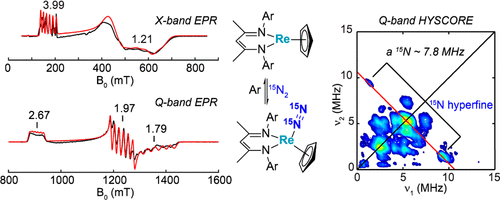当前位置:
X-MOL 学术
›
J. Am. Chem. Soc.
›
论文详情
Our official English website, www.x-mol.net, welcomes your feedback! (Note: you will need to create a separate account there.)
Electronic Structures of Rhenium(II) β-Diketiminates Probed by EPR Spectroscopy: Direct Comparison of an Acceptor-Free Complex to Its Dinitrogen, Isocyanide, and Carbon Monoxide Adducts
Journal of the American Chemical Society ( IF 15.0 ) Pub Date : 2020-07-28 , DOI: 10.1021/jacs.0c04719 Trevor D Lohrey 1, 2 , Guodong Rao 3 , David W Small 1 , Erik T Ouellette 1, 2 , Robert G Bergman 1 , R David Britt 3 , John Arnold 1, 2
Journal of the American Chemical Society ( IF 15.0 ) Pub Date : 2020-07-28 , DOI: 10.1021/jacs.0c04719 Trevor D Lohrey 1, 2 , Guodong Rao 3 , David W Small 1 , Erik T Ouellette 1, 2 , Robert G Bergman 1 , R David Britt 3 , John Arnold 1, 2
Affiliation

|
Electron paramagnetic resonance (EPR) studies of the rhenium(II) complex Re(η5-Cp)(BDI) (1; BDI = N,N'-bis(2,6-diisopropylphenyl)-3,5-dimethyl-β-diketiminate) have revealed that this species reversibly binds N2 in solution: flash frozen toluene solutions of 1 disclose entirely different EPR spectra at 10 K when prepared under N2 versus Ar atmospheres. This observation was additionally verified by the synthesis of stable CO and 2,6-xylylisocyanide (XylNC) adducts of 1, which display EPR features akin to those observed in the putative N2 complex. While we found that 1 displays an extremely large gmax value of 3.99, the binding of an additional ligand leads to substantial decreases in this value, displaying gmax values of ca. 2.4. Following the generation of isotopically enriched 15N2 and 13CO adducts of 1, HYSCORE experiments allowed for the measurement of the corresponding hyperfine couplings associated with spin delocalization onto the electron-accepting ligands in these species, which proved to be small. A cumulative assessment of the EPR data, when combined with insights provided by near-infrared (NIR) spectroscopy and time-dependent density functional theory (TDDFT) calculations, indicated that while the binding of electron acceptors to 1 does lead to decreases in gmax in relative accord with the field strength (i.e., π-acidity) of the variable ligand, the magnitude of these decreases is primarily due to the changes in electronic structure at the Re center.
中文翻译:

EPR 光谱探测铼 (II) β-二酮亚胺的电子结构:无受体配合物与其二氮、异氰化物和一氧化碳加合物的直接比较
铼 (II) 配合物 Re(η5-Cp)(BDI) (1; BDI = N,N'-双(2,6-二异丙基苯基)-3,5-二甲基-β-的电子顺磁共振 (EPR) 研究diketimate) 揭示了该物种在溶液中可逆地结合 N2:当在 N2 与 Ar 气氛下制备时,1 的闪冻甲苯溶液在 10 K 下显示完全不同的 EPR 光谱。通过合成稳定的 CO 和 1 的 2,6-二甲苯异氰化物 (XylNC) 加合物进一步验证了这一观察结果,其显示的 EPR 特征类似于在推定的 N2 复合物中观察到的特征。虽然我们发现 1 显示了 3.99 的极大 gmax 值,但附加配体的结合导致该值显着降低,显示 gmax 值为 ca。2.4. 在产生 1 的同位素富集 15N2 和 13CO 加合物后,HYSCORE 实验允许测量与自旋离域相关的相应超精细耦合到这些物种中的电子接受配体上,事实证明这种耦合很小。EPR 数据的累积评估,结合近红外 (NIR) 光谱和时间相关密度泛函理论 (TDDFT) 计算提供的见解,表明虽然电子受体与 1 的结合确实导致 gmax 在与可变配体的场强(即 π 酸度)相对一致,这些下降的幅度主要是由于 Re 中心电子结构的变化。
更新日期:2020-07-28
中文翻译:

EPR 光谱探测铼 (II) β-二酮亚胺的电子结构:无受体配合物与其二氮、异氰化物和一氧化碳加合物的直接比较
铼 (II) 配合物 Re(η5-Cp)(BDI) (1; BDI = N,N'-双(2,6-二异丙基苯基)-3,5-二甲基-β-的电子顺磁共振 (EPR) 研究diketimate) 揭示了该物种在溶液中可逆地结合 N2:当在 N2 与 Ar 气氛下制备时,1 的闪冻甲苯溶液在 10 K 下显示完全不同的 EPR 光谱。通过合成稳定的 CO 和 1 的 2,6-二甲苯异氰化物 (XylNC) 加合物进一步验证了这一观察结果,其显示的 EPR 特征类似于在推定的 N2 复合物中观察到的特征。虽然我们发现 1 显示了 3.99 的极大 gmax 值,但附加配体的结合导致该值显着降低,显示 gmax 值为 ca。2.4. 在产生 1 的同位素富集 15N2 和 13CO 加合物后,HYSCORE 实验允许测量与自旋离域相关的相应超精细耦合到这些物种中的电子接受配体上,事实证明这种耦合很小。EPR 数据的累积评估,结合近红外 (NIR) 光谱和时间相关密度泛函理论 (TDDFT) 计算提供的见解,表明虽然电子受体与 1 的结合确实导致 gmax 在与可变配体的场强(即 π 酸度)相对一致,这些下降的幅度主要是由于 Re 中心电子结构的变化。


























 京公网安备 11010802027423号
京公网安备 11010802027423号